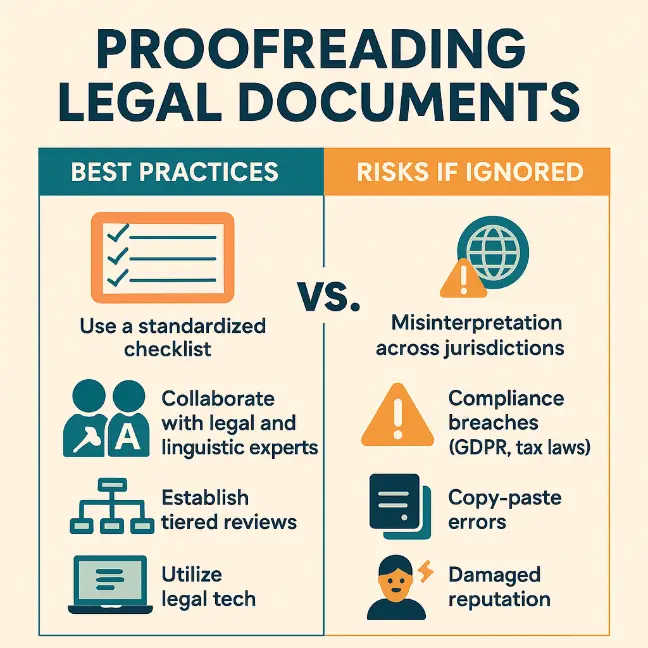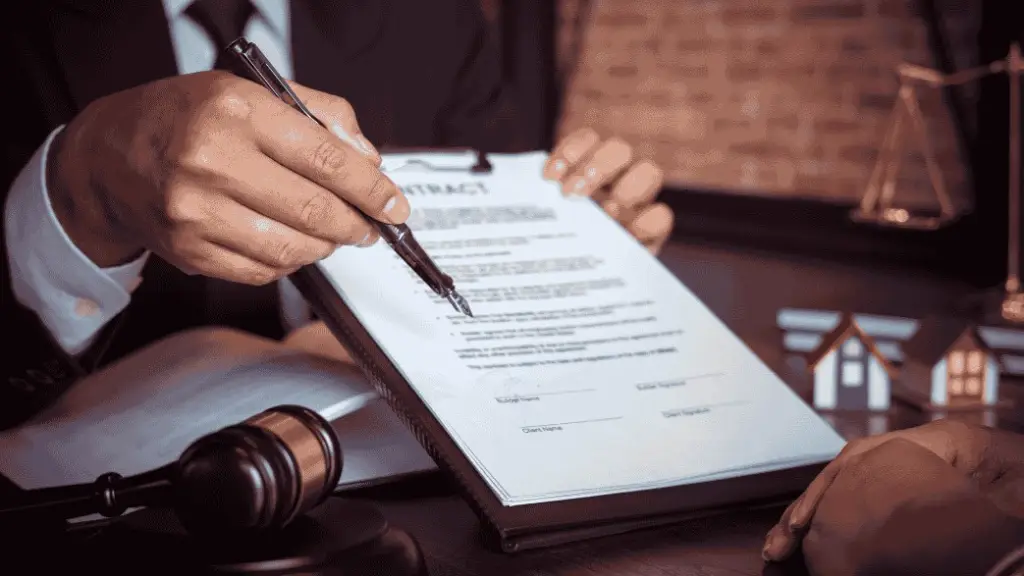In the high-stakes world of global business-to-business (B2B) transactions, every word in a legal document carries weight. An error, omission, or ambiguous clause can result in misunderstandings, litigation, or financial loss. That’s why rigorous proofreading is a non-negotiable step in preparing legal documents. This article dives into why proofreading is essential, explores key best practices, and outlines how B2B firms can avoid costly risks.
Why Proofreading Legal Documents Matters for Global B2B Firms
Legal proofreading is more than spotting typos. It’s about clarity, precision, and ensuring compliance with international and jurisdiction-specific standards.
Proofreading legal documents ensures accuracy, clarity, and compliance across jurisdictions. For global B2B firms, even minor errors can lead to costly disputes or reputational damage. A meticulous review safeguards against misinterpretation, reinforces professionalism, and builds trust with partners, clients, and regulators-making it an indispensable step in legal operations.
Avoiding Misinterpretation Across Jurisdictions
For global B2B firms, documents often span multiple legal systems. What might be standard in the U.S. could be vague or non-compliant in the EU.
Protecting Your B2B Brand Reputation
A poorly drafted or error-filled document doesn’t just cause legal issues-it reflects badly on your brand. A polished legal document communicates professionalism and diligence.
Best Practices for Proofreading Legal Documents in Global B2B Firms
Establishing a robust proofreading process protects against errors and boosts legal document integrity.
Use a Standardized Proofreading Checklist
Having a checklist ensures consistency and prevents missed steps.
Core Elements of a Legal Proofreading Checklist
- Spelling, grammar, and punctuation
- Clause consistency and correct referencing
- Formatting and numbering accuracy
- Signature blocks and date formats
Advanced Checks
- Local legal terminology verification
- Compliance with applicable regulations (e.g., GDPR, CCPA)
- Translation consistency (for multilingual documents)
Collaborate With Legal and Linguistic Experts
Language professionals can spot grammar or usage errors, while legal professionals ensure content is accurate and compliant.
Collaborating with legal and linguistic experts combines precise legal knowledge with language mastery. Legal professionals ensure compliance and accuracy, while linguistic experts refine clarity, tone, and grammar. This partnership minimizes misunderstandings, strengthens contractual language, and ensures documents meet both legal standards and cultural expectations-crucial for global B2B transactions.
Establish Review Tiers
- First tier: In-house legal counsel for legal accuracy
- Second tier: Linguistic experts or editors for grammar/style
- Third tier: External legal consultants (when necessary)
Avoiding Common Legal Document Risks with Rigorous Proofreading
Legal documents often contain boilerplate content reused across deals. But even standardized language can create risk if it’s not reviewed in context.
Copy-Paste Errors
Errors often arise when text is reused from previous agreements.
How to Minimize Copy-Paste Errors in B2B Legal Documents
- Rephrase reused content to fit the specific context
- Use document comparison tools to highlight differences
- Employ document version control software
Regulatory and Compliance Pitfalls: Proofreading to Ensure Global Compliance
With global transactions, firms must account for laws across jurisdictions. A minor oversight can lead to non-compliance.
For example, an unproofed international sales agreement might omit mandatory GDPR data protection clauses, misstate applicable VAT rules, and include an outdated arbitration provision naming a defunct tribunal. These oversights could lead to regulatory fines, tax disputes, and unenforceable dispute resolution terms-exposing the parties to avoidable legal and financial risks.
Examples of Risky Omissions
- Not including required data protection clauses (GDPR, HIPAA)
- Ambiguous arbitration or jurisdiction clauses
- Incorrect cross-border tax obligations

Source: Inkorporated
Legal Technologies That Enhance Proofreading Accuracy
Technology isn’t a replacement for human reviewers but is essential for efficiency and risk reduction.
AI-Powered Legal Editing Tools
Tools like Grammarly, Microsoft Editor, and legal-specific platforms like Litera or BriefCatch support faster, more accurate review.
Key Features to Leverage
- Contract clause flagging
- Legal terminology suggestions
- Citation verification
Version Control and Document Tracking
Using version control platforms ensures you track every change and maintain a reliable audit trail.
Benefits
- Reduce duplication and overwrite errors
- Ensure accountability through tracked edits
- Protect sensitive legal drafts via access controls
How to Align Proofreading with Legal Workflows for Efficiency & Compliance
Proofreading isn’t just a task-it should be embedded in your legal ops strategy.
Create a Legal Document Review Protocol
A legal document review protocol defines review stages, assigns responsibilities, and sets timelines. It should outline drafting, initial proofreading, legal accuracy checks, final edits, and approval procedures. Standardized checklists, version control, and clear communication channels ensure consistency, compliance, and accountability-reducing risks and enhancing document quality across the organization.
Recommended Workflow Stages
- Drafting by legal or compliance team
- First proofreading pass by editor
- Legal review
- Final proofreading pass
- Approval and version lock
Train the Team
Even experienced teams benefit from ongoing training in legal writing and proofreading.
Focus Areas
- Jurisdiction-specific legal writing
- Legal English for non-native speakers
- Use of proofreading tech
Final Take: Why Proofreading is a Non-Negotiable for Global B2B Legal Success
Proofreading legal documents is a high-value, low-cost investment that pays off by reducing risk and reinforcing trust. For global B2B firms, where contracts and legal agreements cross borders and languages, it’s essential to create a culture of meticulous review. Implementing best practices, leveraging tech, and training teams are vital steps toward airtight documentation.
In today’s interconnected marketplace, legal precision is not just about avoiding disputes-it’s about enabling smooth, confident transactions across jurisdictions. A comprehensive proofreading framework helps prevent costly errors, ensures compliance, and strengthens stakeholder relationships. By embedding proofreading into your legal operations strategy, you safeguard your brand’s credibility, maintain regulatory alignment, and create a foundation for sustainable growth. Whether dealing with a single contract or a portfolio of cross-border agreements, the effort invested in thorough, collaborative review will pay dividends in legal certainty, operational efficiency, and global trust.
Looking to strengthen your legal proofreading process? Contact Us to learn how we can help you scale editorial quality across jurisdictions.

